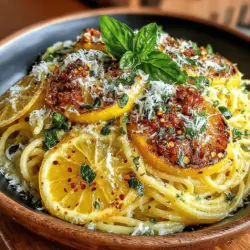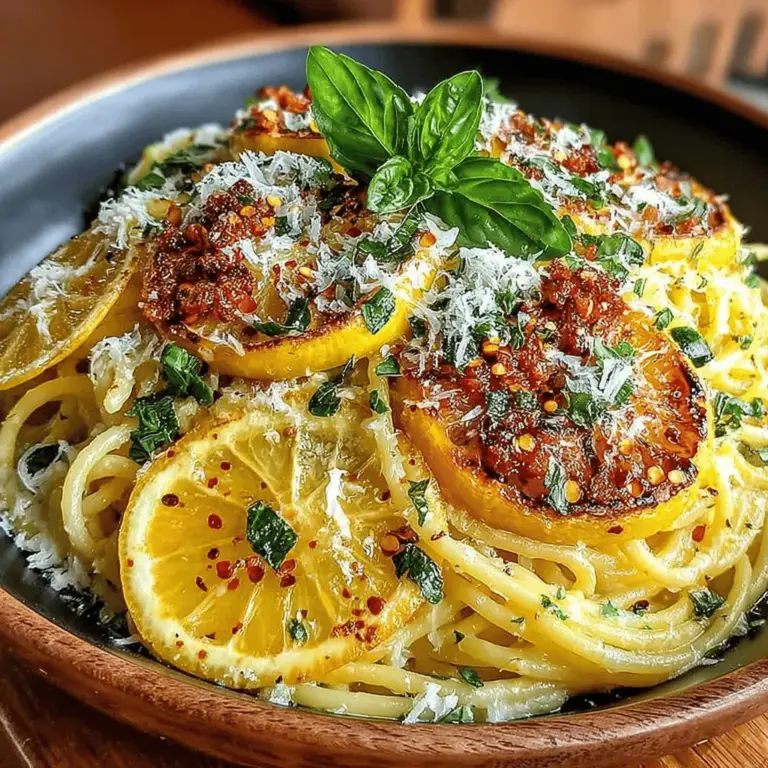Zesty Lemon Ricotta Pasta: A Bright and Creamy Delight
Pasta dishes have long been a staple in kitchens around the world, thanks to their versatility and comforting nature. Among the myriad of pasta recipes, Zesty Lemon Ricotta Pasta stands out for its vibrant flavors and creamy texture. This dish combines the richness of fresh ricotta with the bright acidity of lemon, creating a delightful balance that enlivens the palate. Perfect for a quick weeknight dinner or an elegant meal for special occasions, this recipe showcases how simple ingredients can come together to create something truly special.
The appeal of Zesty Lemon Ricotta Pasta lies not only in its flavor but also in its ease of preparation. With minimal cooking time and straightforward steps, even novice cooks can impress their friends and family with this dish. As we dive into the recipe, you’ll discover how to harness the power of fresh ingredients to create a pasta dish that is both satisfying and refreshing.
Understanding the Ingredients
To create a truly memorable Zesty Lemon Ricotta Pasta, it’s essential to understand the key ingredients that contribute to its unique flavor profile. Each component serves a purpose, enhancing the overall dish and providing a well-rounded culinary experience.
Fresh Ricotta Cheese
At the heart of this pasta dish is fresh ricotta cheese, known for its creamy texture and subtle flavor. Unlike some cheeses that can be overwhelming, ricotta offers a lightness that pairs beautifully with pasta. Its smooth consistency allows it to blend seamlessly into sauces, creating a creamy coating that clings to each strand of pasta. When selecting ricotta, opt for high-quality, fresh varieties that are free from additives to ensure the best flavor and texture.
Lemon Zest and Juice
Lemon plays a pivotal role in this recipe, imparting brightness and acidity that elevates the dish. The zest of the lemon contains aromatic oils that provide a concentrated burst of citrus flavor, while the juice adds a refreshing tartness that balances the richness of the ricotta. Together, they create a lively contrast that enhances the overall taste, making each bite more enjoyable. When preparing this dish, using fresh lemons is crucial; bottled lemon juice lacks the vibrant flavor and fragrance that fresh lemons provide.
Parmesan Cheese
To further enrich the flavor, grated Parmesan cheese is incorporated into the sauce. Parmesan adds a delightful saltiness and depth that complements the creamy ricotta and tangy lemon. When selecting Parmesan, look for aged varieties that are well-aged, as they typically offer a more robust flavor. Freshly grated cheese is always preferable, as it melts more easily and enhances the sauce’s texture.
Extra Virgin Olive Oil
A drizzle of high-quality extra virgin olive oil is essential for bringing the dish together. Olive oil not only adds a layer of richness but also contributes healthy fats that are beneficial for heart health. When cooking, using good quality olive oil can make a significant difference in flavor, so don’t skimp on this ingredient. A fruity, robust olive oil can elevate the overall taste of the dish and enhance the other flavors.
Garlic and Red Pepper Flakes
Finally, garlic and red pepper flakes round out the flavor profile. Garlic adds an aromatic depth that complements the creamy and tangy elements of the dish, while red pepper flakes introduce a subtle heat that can be adjusted to personal preference. This combination of flavors creates a well-rounded dish that is exciting and satisfying.
Cooking the Pasta Perfectly
Now that we’ve explored the ingredients, let’s focus on the first crucial step: cooking the pasta to perfection. For this recipe, spaghetti or linguine are excellent choices, as their long strands work beautifully with the creamy sauce.
1. Boil the Water: Start by bringing a large pot of salted water to a boil. The water should be seasoned generously; this is your opportunity to infuse flavor into the pasta itself. As a general rule, aim for about 1-2 tablespoons of salt per gallon of water.
2. Cooking the Pasta: Once the water is at a rolling boil, add the pasta. Stir occasionally to prevent sticking. Cooking times will vary depending on the type of pasta you choose; refer to the package instructions for guidance. For al dente pasta, aim to cook it for about 1-2 minutes less than the suggested time.
3. Reserve Pasta Water: As the pasta nears completion, remember to reserve about a cup of the starchy pasta water before draining. This water will be invaluable for adjusting the consistency of the sauce later on.
4. Timing is Key: It’s crucial to time the cooking of the pasta with the preparation of the sauce. Ideally, you want the pasta to finish cooking just as your sauce is ready to combine. This ensures that the pasta stays fresh and hot, allowing it to absorb the flavors of the sauce more effectively.
Crafting the Creamy Ricotta Sauce
As the pasta cooks, you can begin crafting the creamy ricotta sauce that will envelop the pasta in a luscious coating.
1. Prepare the Sauce Base: In a large skillet over medium heat, add a generous drizzle of extra virgin olive oil. Once hot, add minced garlic and sauté until fragrant, about 30 seconds. Be careful not to let the garlic brown, as it can become bitter.
2. Incorporate the Ricotta: Lower the heat and add the fresh ricotta to the skillet. Use a spatula to break it up and incorporate it with the garlic and olive oil. Stir gently until the ricotta is creamy and warmed through.
3. Add Lemon: Next, add the zest and juice of one or two lemons, depending on your taste preference. Stir to combine, allowing the lemon to brighten the sauce. If the sauce appears too thick, gradually add some reserved pasta water until you reach your desired consistency.
4. Seasoning: Finish the sauce by adding grated Parmesan cheese, salt, and red pepper flakes to taste. Mix until the cheese is melted and the sauce is creamy. Taste and adjust the seasonings as necessary, ensuring a perfect balance of flavors.
With the pasta cooked and the ricotta sauce prepared, you’re now ready to combine these elements into a delightful dish that captures the essence of summer with every bite. The next steps will involve bringing the pasta and sauce together to create a harmonious blend of flavors and textures. Stay tuned as we explore how to finish this Zesty Lemon Ricotta Pasta to perfection.
{{image_2}}
Techniques for Achieving Creamy Consistency
To create a perfectly creamy texture for your Zesty Lemon Ricotta Pasta, it’s essential to master the use of reserved pasta water. As you cook your pasta, remember to save about a cup of the starchy water before draining. This water is crucial in achieving the desired consistency for your sauce. The starch helps bind the sauce to the pasta, creating a silky coating rather than a clumpy mixture.
Using Reserved Pasta Water
1. Start with the Right Amount: After boiling the pasta, scoop out a cup of the cooking water. You can always add more as needed, but starting with a small amount helps control the sauce’s thickness.
2. Incorporate Gradually: Once you’ve mixed the ricotta and lemon juice with the pasta, begin adding the reserved water in small increments. Stir continuously to facilitate the emulsification process. This technique combines the flavors while ensuring a creamy consistency without making it soupy.
3. Assess the Texture: If the sauce seems too thick, add more pasta water until it reaches your preferred creaminess. The goal is to have a sauce that clings to each strand of pasta, providing richness without overwhelming the dish.
Suggestions for Sauce Variations
While the classic Zesty Lemon Ricotta Pasta is delightful as is, don’t hesitate to experiment with different flavors and textures to personalize your dish. Here are a few suggestions:
Incorporating Fresh Herbs
Adding fresh herbs can elevate the flavor profile significantly. Consider the following options:
– Basil: Fresh basil pairs beautifully with lemon and ricotta, adding a sweet, aromatic note.
– Parsley: Chopped parsley adds freshness and a hint of bitterness that balances the richness of the cheese.
– Chives: Finely chopped chives can provide a subtle onion flavor, enhancing the overall taste.
Cheese Variations
Experiment with different types of cheese to create unique flavor combinations:
– Feta: For a tangy twist, crumbled feta can complement the lemon and provide an interesting texture.
– Parmesan: A classic choice, freshly grated Parmesan can add a nutty flavor and enhance the creaminess of the dish.
– Goat Cheese: Creamy goat cheese can bring a distinct tangy flavor that pairs wonderfully with lemon.
Combining Pasta and Sauce
Tossing for Even Coating
To achieve an evenly coated pasta dish, follow these steps:
1. Add Pasta to the Sauce: After draining your pasta, directly add it to the pan with the prepared lemon-ricotta sauce over low heat. This allows the pasta to absorb some of the sauce’s flavors while reheating.
2. Toss Gently: Use tongs or a pasta fork to gently toss the pasta with the sauce. Be careful not to break the pasta; a gentle hand helps maintain the integrity of the noodles.
3. Incorporate Pasta Water: As you toss, gradually add the reserved pasta water until the desired creamy consistency is achieved. This will help create a cohesive dish where every strand is well coated.
Seasoning for Maximum Flavor
Proper seasoning is crucial for enhancing the dish’s flavor profile. Here are some tips to ensure your pasta is well-seasoned:
– Salt the Cooking Water: Make sure to salt your pasta cooking water generously. This step is vital as it allows the pasta to absorb some salt during cooking, creating a flavorful base.
– Taste and Adjust: After combining the pasta and sauce, taste the dish. If it lacks flavor, consider adding a pinch of salt, a squeeze of lemon juice, or freshly cracked black pepper to balance the flavors.
– Finish with Fresh Ingredients: A final sprinkle of freshly chopped herbs or a drizzle of high-quality olive oil can enhance the overall flavor and presentation.
Garnishes for Enhanced Presentation
To elevate the presentation of your Zesty Lemon Ricotta Pasta, consider these garnishing ideas:
– Fresh Herbs: A sprinkle of chopped basil or parsley on top of the pasta not only adds color but also freshness to each bite.
– Zest: Grate some lemon zest over the dish just before serving for an extra burst of citrus aroma and flavor.
– Cheese: A light dusting of freshly grated Parmesan or crumbled feta can make the dish visually appealing while adding an extra layer of flavor.
Serving Suggestions
Plating the Dish
Presentation is key to making your Zesty Lemon Ricotta Pasta visually appealing. Here are some tips for plating:
– Use Shallow Bowls: Serve the pasta in shallow bowls to create a more elegant presentation. This allows the vibrant colors of the dish to shine through and provides ample space for garnishes.
– Twist the Pasta: When placing the pasta in the bowl, use a fork to twist the strands into a nest-like shape. This technique creates height and visual interest.
– Layer Garnishes: Always layer your garnishes on top, using fresh herbs and cheese as finishing touches. This adds dimension and makes the dish inviting.
Wine Pairings and Side Dishes
Pairing your pasta with the right beverage and side dishes can enhance the overall dining experience:
– Wine Pairings: A light, crisp white wine such as Pinot Grigio or Sauvignon Blanc complements the zesty flavors of the dish. These wines have enough acidity to match the lemon and ricotta without overpowering the dish.
– Side Dishes: Consider serving a simple arugula salad dressed with lemon vinaigrette or garlic bread on the side. These additions provide a nice contrast to the creamy pasta and keep the meal light.
Versatility of the Dish
One of the best aspects of Zesty Lemon Ricotta Pasta is its versatility. It can serve as:
– A Main Course: Perfect for a light lunch or dinner, this pasta can stand alone as a satisfying meal.
– A Side Dish: Pair it with grilled chicken, fish, or roasted vegetables for a hearty yet refreshing side.
Nutritional Benefits
Overview of Nutritional Aspects
This dish not only delights the palate but also offers several nutritional benefits:
– Ricotta: A great source of protein and calcium, ricotta cheese contributes to muscle health and bone density. It’s also lower in fat than many other cheeses, making it a healthier choice.
– Lemon: Rich in vitamin C and antioxidants, lemons can boost the immune system and promote healthy skin.
– Olive Oil: A healthy source of monounsaturated fats, olive oil supports heart health and provides anti-inflammatory benefits.
Balanced Nutritional Profile
The balance of carbohydrates, proteins, and healthy fats in this meal makes it a well-rounded option. The pasta provides energy through carbohydrates, while the ricotta and olive oil deliver essential proteins and fats, ensuring a satisfying meal that keeps you full.
Dietary Accommodations
Zesty Lemon Ricotta Pasta can easily accommodate various dietary preferences, including:
– Vegetarian Options: This dish is inherently vegetarian, making it suitable for those avoiding meat.
– Gluten-Free Variations: Substitute traditional pasta with gluten-free alternatives, such as quinoa or chickpea pasta, to cater to gluten-intolerant diners.
Conclusion
In summary, Zesty Lemon Ricotta Pasta is a delightful combination of simplicity, flavor, and versatility. Mastering the creamy consistency, experimenting with variations, and incorporating thoughtful serving suggestions allow this dish to shine in any setting.
Cooking is not just about nourishment; it’s about the joy of creating and sharing delightful meals with loved ones. We encourage you to try making this Zesty Lemon Ricotta Pasta and relish in the experience it brings to your dining table. Enjoy the process, the flavors, and the satisfaction of a homemade dish that is sure to impress.


